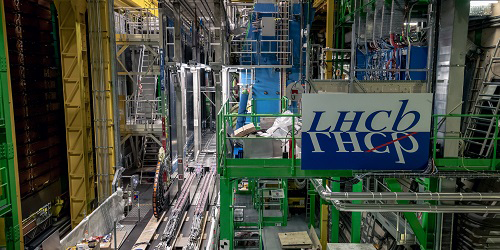Three’s Company for Bottom Quarks
A quark—a fundamental constituent of matter—cannot exist in isolation. Instead, theory predicts that quarks typically couple together in mesons or throuple in baryons. Now the LHCb Collaboration at CERN in Switzerland shows that baryon formation is more common in dense environments than in sparse ones if a specific quark called a bottom quark is present [1]. This finding has implications for our understanding of how elementary particles consolidate to form visible matter.
The LHCb Collaboration studied the particles created in high-energy proton–proton collisions at CERN’s Large Hadron Collider. Specifically, the collaboration’s members examined the production rates of baryons and mesons—composite objects that each contain one bottom quark. The team monitored relative changes between these two production rates for proton–proton collisions that created charged particles in different numbers and with different transverse momenta.
The collaboration found that the production rate of baryons increased relative to that of mesons as the number of charged particles increased or as the transverse momentum of the particles decreased. These trends imply that, as the particle environment becomes denser, bottom quarks are increasingly more likely to be incorporated into baryons, as opposed to mesons. The team says that this result disfavors conventional particle-physics models in which the consolidation of quarks is independent of the particle environment. Instead, it fits with alternative particle-physics models in which baryon formation depends on the environment’s density.
–Ryan Wilkinson
Ryan Wilkinson is a Corresponding Editor for Physics Magazine based in Durham, UK.
References
- R. Aaij et al. (LHCb Collaboration), “Enhanced production of baryons in high-multiplicity pp collisions at TeV,” Phys. Rev. Lett. 132, 081901 (2024).




